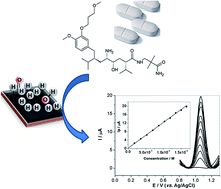Analytical determination of aliskiren in pharmaceutical formulations using boron-doped diamond electrodes
Abstract
Here, we developed a simple and sensitive electroanalytical methodology and quantified aliskiren in pharmaceutical formulations, as well as in human serum samples by square-wave voltammetry. The analytical signal response was obtained by electrochemical oxidation of the aliskiren drug at a boron-doped diamond (BDD) electrode. The determination was carried out in 0.04 M Britton–Robinson pH 8 buffer solution. Aliskiren oxidation reveals a well-defined irreversible oxidation peak. The analytical curve was obtained in the concentration range from 1.81 × 10−5 to 1.63 × 10−4 M (r = 0.997). Limits of detection and quantification for aliskiren were 2.5 × 10−8 and 8.4 × 10−8 M, respectively. Recovery values were in the range of 98.2–100.2%, indicating no matrix interference effects on the analytical determination of aliskiren in commercial samples. The presence of interferents commonly found in human serum negligibly affects the electroanalytical response of aliskiren yielding good average recoveries of 95.5–97.8% after standard-solution additions. The BDD electrode exhibited a stable, selective and sensitive response to aliskiren in the presence of interferents.


 Please wait while we load your content...
Please wait while we load your content...